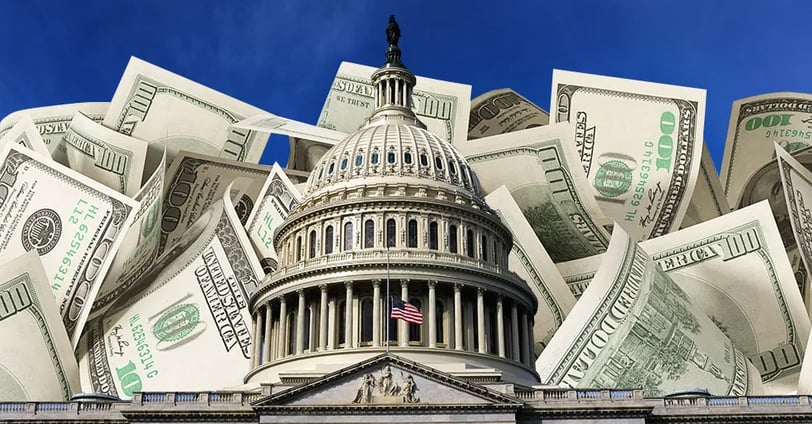Is a U.S. Default Imminent? Understanding the Risks and Safeguards
Explore the escalating U.S. national debt, historical precedents of financial policy shifts, and current debates on the possibility of a U.S. default. Learn how investors can navigate these challenges and protect their assets.
CRYPTOCURRENCYGEOPOLITICSMACROECONOMYUS
6/4/20253 min read


The United States has long been a beacon of economic stability, but recent fiscal trends are raising concerns about its financial future. The national debt has been on an upward trajectory, prompting discussions about the potential for a U.S. default.
The Escalating U.S. National Debt
As of January 2025, the U.S. federal debt stands at approximately $36.22 trillion, with debt held by the public at $28.9 trillion and intragovernmental holdings at $7.31 trillion. This equates to about 124% of the nation's Gross Domestic Product (GDP). (jec.senate.gov)
The Congressional Budget Office (CBO) projects that federal debt will rise from 99% of GDP in 2024 to 116% by 2034, and continue to grow, reaching 172% of GDP by 2054 if current laws remain unchanged.
Historical Precedents of Financial Policy Shifts
The U.S. has a history of altering its monetary policies in response to economic pressures:
1933 Gold Confiscation: During the Great Depression, President Franklin D. Roosevelt issued Executive Order 6102, mandating citizens to surrender their gold coins, gold bullion, and gold certificates to the Federal Reserve. This move aimed to stabilize the banking system but is often viewed as a form of default on the government's gold-backed obligations.
1971 Nixon Shock: In response to inflation and a declining gold reserve, President Richard Nixon suspended the convertibility of the U.S. dollar into gold, effectively ending the Bretton Woods system. This decision marked a significant shift in U.S. monetary policy and is considered a de facto default on gold-backed commitments.
Arguments Supporting the Possibility of a U.S. Default
Several factors contribute to concerns about a potential U.S. default:
Rising Debt Levels: The continuous increase in national debt raises questions about the government's ability to meet its obligations without resorting to unconventional measures.
Interest Payments: Interest payments on the national debt have been consuming a larger portion of the federal budget, sometimes exceeding expenditures on national defense. (reuters.com)
Global Confidence: Persistent fiscal deficits and debt accumulation may erode international confidence in U.S. Treasury securities, potentially leading to reduced demand and higher borrowing costs.
Arguments Against the Likelihood of a U.S. Default
Conversely, several factors suggest that a U.S. default is unlikely:
Reserve Currency Status: The U.S. dollar's role as the world's primary reserve currency provides the government with significant borrowing capacity and flexibility.
Economic Resilience: The U.S. economy's size and diversity offer a buffer against fiscal challenges, enabling the government to implement policies to manage debt levels.
Monetary Policy Tools: The Federal Reserve has a range of tools, including adjusting interest rates and quantitative easing, to influence economic conditions and manage debt.
Investor Considerations and Future Outlook
Investors should monitor key indicators to assess the risk of a U.S. default:
Debt-to-GDP Ratio: A rising ratio may signal increasing fiscal strain.
Interest Payment Trends: Escalating interest payments relative to GDP could indicate potential challenges in debt servicing.
Global Economic Conditions: International economic trends can impact the U.S. economy and its fiscal policies.
In the near future, investors can expect continued debates over fiscal policy, potential adjustments to the debt ceiling, and discussions on sustainable debt management strategies.
Potential Government Actions and Wealth Protection Strategies
In scenarios where the government seeks to manage debt through unconventional means, it may consider:
Asset Confiscation: Historical precedents suggest that the government could implement measures such as gold confiscation to stabilize the economy.
To safeguard assets, investors might consider:
Precious Metals: Gold and silver have historically served as hedges against inflation and currency devaluation.
Real Estate: Property investments can provide tangible value and potential income streams.
Equities: Stocks in diverse sectors can offer growth opportunities and dividends.
Cryptocurrencies: Assets like Bitcoin are viewed by some as stores of value and potential hedges against traditional financial system risks.
By diversifying investments across these assets, individuals can enhance their financial resilience in uncertain economic times.
Stay updated with finance news and trends.
Contact
info@bullsandbearsblog.com
© 2025. All rights reserved.


